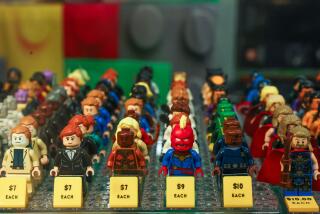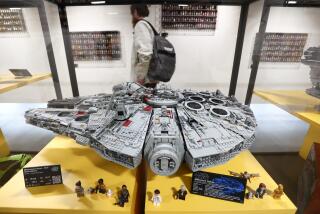Lego goes to the girls: New products feminist or sexist?
- Share via
Lego’s sales and profits are soaring as the rest of the toy market struggles – and it has girls to thank.
Twice as many girl-centric Lego Friends sets were sold than expected in the first six months of the year, the Danish company said. Production of the merchandise has been ramped up for Christmas.
The controversial product line, unveiled in December, features a cast of female dolls – or “Ladyfigs,” as they were dubbed – living in fictional Heartlake City. Sets include Butterfly Beauty Shop, Andrea’s Bunny House, Emma’s Design Studio and six other backdrops involving puppies, horses or other pets.
They helped Lego pull in 36% more profit in the first half of 2012 – 2 billion kroner, or $341.2 million – compared to the same period last year, the 80-year-old company said Friday. Revenue jumped 24% to $1.5 billion.
When the Ladyfigs went on the market complete with curvy figures and budding breasts, feminists and other activists accused Lego of reinforcing gender stereotypes.
The company is known for its yellow figurines and colorful blocks, which have often been used to construct robots, pirate ships, buildings and more. Its Lego City and Lego “Star Wars” product lines are still its best-selling items.
The SPARK Movement, which aims to end the sexualization of women and girls in media, derided Lego Friends as “a pink Barbielicious product line for girls, so 5-year-olds can imagine themselves at the cafe, lounging at the pool with drinks, brushing their hair in front of a vanity mirror, singing in a club, or shopping with their girlfriends.”
The activist group put up a petition on Change.org demanding that Lego “stop selling out girls.” Nearly 60,000 people have signed it since. Lego met with the group and put out a statement that it wants “to increase the number of girls who currently try and engage with the positive benefits of the construction play pattern.”
On Friday, Lego Chief Executive Jorgen Vig Knudstorp called sales of Lego Friends “astonishing.”
“We’ve managed to make creative construction toys more relevant for girls – and we look forward to developing the product line further in the years ahead,” he said.
The company’s strong performance comes as the rest of the international toy market is dealing with the pressure of a weak economy. Knudstorp said the overall industry softened by 4% in the first half of the year, helping Lego boost its market share to more than 8%.
Sales soared 23% in the U.S. and even more in Asia, causing Lego to predict that it will need to hire 1,000 new workers in 2012 to meet demand.
Lego competitor Mattel Inc. also had strong earnings recently. The El Segundo company said its second-quarter profit rose nearly 20% for the period ended June 30, though sales remained flat at $1.16 billion.
Hasbro Inc.’s net income, however, slumped 25% in its second quarter. Revenue slipped more than 10%.
ALSO:
Mattel’s profit rose nearly 20% in second quarter
Toys R Us CEO talks about revamping stores, knocking down walls
Toy company Hasbro reports profit slump after Mattel says sales down
Follow Tiffany Hsu on Twitter and Google+
More to Read
Inside the business of entertainment
The Wide Shot brings you news, analysis and insights on everything from streaming wars to production — and what it all means for the future.
You may occasionally receive promotional content from the Los Angeles Times.











